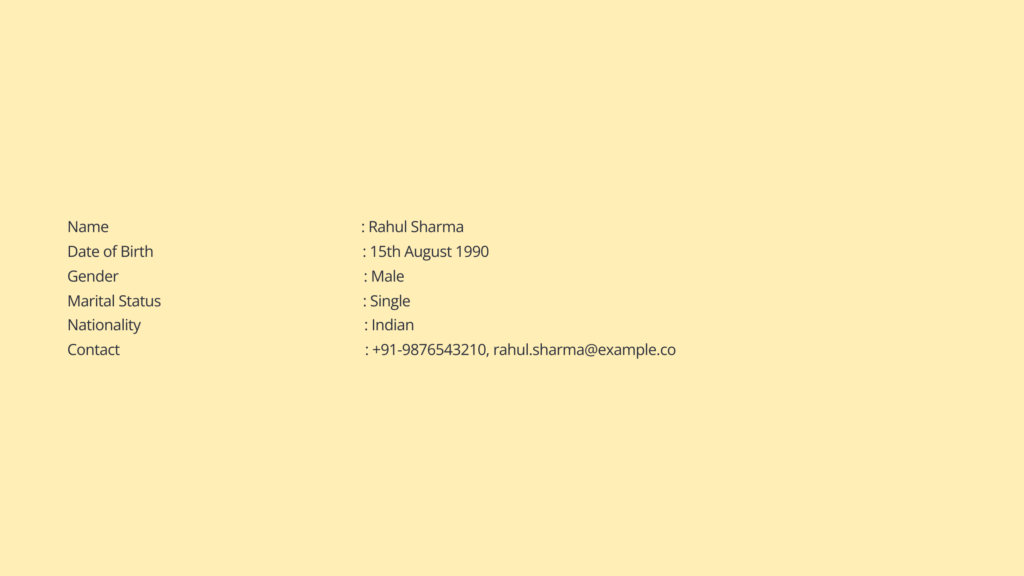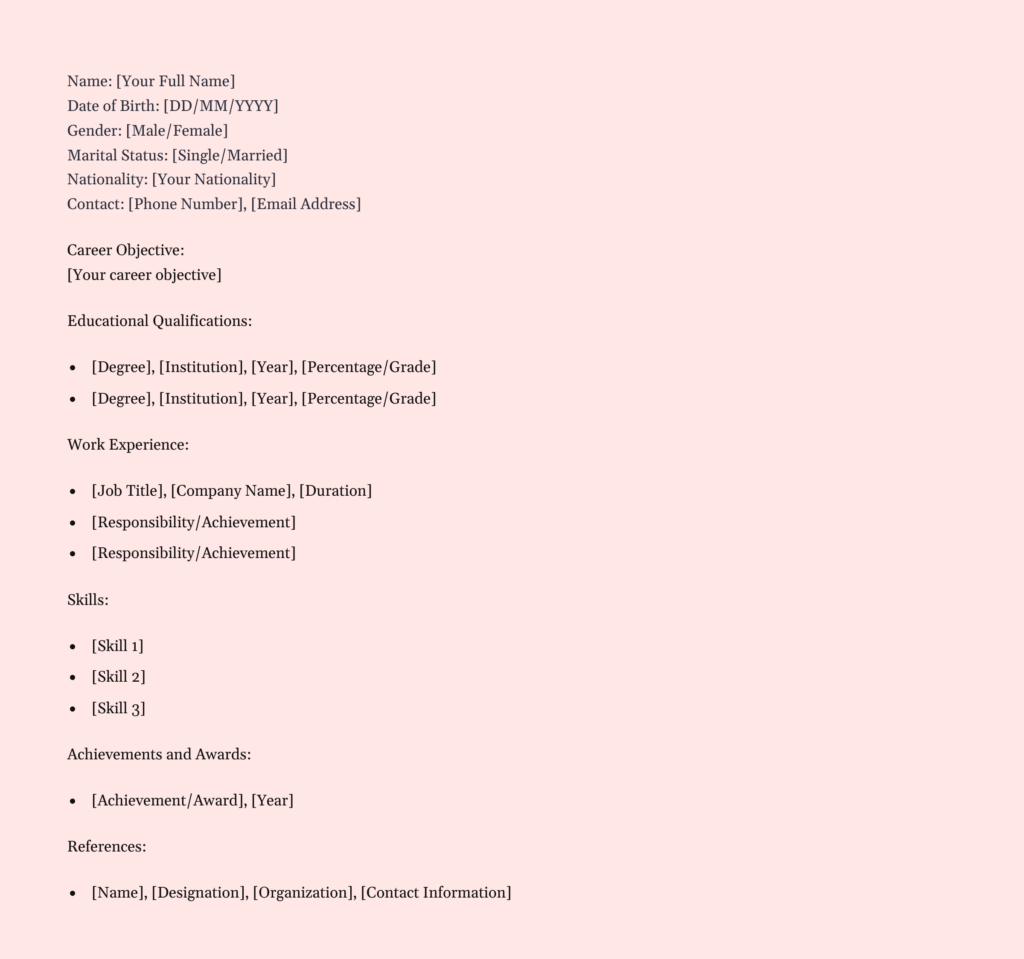[ad_1]
Creating an effective biodata format for job applications is essential, especially in countries like India where it’s commonly used alongside resumes and CVs. Unlike a standard resume, a biodata includes personal details such as age, gender, marital status, and nationality, offering employers a more complete profile of the candidate. It is particularly popular in government jobs, academic roles, and traditional industries that value comprehensive background information.
A well-structured bio data format not only showcases your qualifications but also reflects your professionalism and attention to detail. This guide will help you understand the key components, formatting tips, and provide sample templates to create an impressive biodata format for job applications that stands out in today’s competitive hiring landscape.
Understanding Bio data
Bio data, short for biographical data, is a structured document that outlines an individual’s personal and professional background. It typically includes personal details such as name, date of birth, gender, marital status, religion, nationality, and contact information—elements that are usually excluded in a modern resume or CV.
The purpose of a bio data is to provide a comprehensive overview of a candidate’s identity and life history, making it a common requirement in more traditional and formal job application settings.
The bio data format for job applications is especially popular in South Asian countries like India, Bangladesh, and Nepal, where it is often used for government roles, academic positions, and matrimonial purposes. Unlike a CV, which focuses more on achievements and skills, the bio data format emphasizes personal details alongside educational qualifications and work experience. This makes it a preferred choice for organizations that value complete background information when evaluating candidates.
Types of Biodata Formats
Understanding the different types of bio data format for job and other purposes helps you tailor your document more effectively. Here are the four most common types:
1. Traditional Bio Data
This is the most basic format and includes extensive personal details such as name, age, gender, religion, caste, marital status, and contact information. It’s commonly used in government jobs and formal institutions where personal background is still considered important.
Use it for:
- Government job applications
- Public sector roles
- Traditional and conservative employers
2. Job-Oriented Bio Data
This format focuses on career-related information—education, work experience, skills, certifications, and professional achievements. Personal details are minimal and only included where necessary.
Use it for:
- Private sector jobs
- Corporate roles
- Professional and skill-based applications
3. Matrimonial Bio Data
Primarily used for matchmaking, this version highlights personal background, family details, religion, interests, and a short self-description. Career and education details are often included but not prioritized.
Use it for:
- Matrimonial websites
- Family-arranged marriage introductions
- Personal biodata sharing
4. Academic Bio Data
Tailored for educational or research roles, this biodata emphasizes academic history, research work, publications, teaching experience, and academic achievements.
Use it for:
- Academic job applications
- Research fellowship programs
- University admissions or teaching posts
Difference Between Resume and Bio Data
| Aspect | Resume | Bio Data |
|---|---|---|
| Focus | Highlights professional achievements, skills, and qualifications | Emphasizes personal details along with education and work experience |
| Personal Information | Includes minimal personal details (e.g., name, contact) | Includes extensive personal info (e.g., age, gender, marital status, religion, etc.) |
| Length | Typically 1–2 pages | Can be longer depending on personal and professional details |
| Usage | Commonly used in private sector and modern industries globally | Preferred in South Asian countries, especially for government, academic, and traditional jobs |
| Tone | Formal and concise, focused on career accomplishments | More descriptive, includes both personal and professional background |
| Purpose | Job applications in corporate, creative, or international roles | Used for job applications, internships, government jobs, and matrimonial purposes |
When to Use a Biodata Instead of a Resume or CV
While resumes and CVs are widely used in modern job markets, there are specific situations where a bio data format for job applications is preferred or even required.
Use a Biodata When:
- Applying for Government Jobs: Many public sector organizations still follow traditional hiring formats that require detailed personal information.
- Traditional or Family-Owned Businesses: Employers in conservative industries may expect a biodata that includes family background, marital status, and other personal details.
- Academic or Administrative Roles: Some educational institutions and clerical posts ask for biodata as part of formal documentation.
- Internships or Campus Placements: For freshers, especially in South Asian countries, biodata is often used during college placements or walk-in interviews.
- Matrimonial Purposes: Though not job-related, biodata is the standard format used in matchmaking and matrimonial proposals.
Key Components of a Job Biodata
1. Personal Information
This section includes:
- Full Name
- Date of Birth
- Gender
- Marital Status
- Nationality
- Contact Details (Address, Phone Number, Email)
Example:


2. Career Objective
A concise statement outlining your career goals and how they align with the company’s objectives.
Example:“To secure a challenging position in a reputable organization to expand my learnings, knowledge, and skills.”
3. Educational Qualifications
List your academic background in reverse chronological order:
- Degree
- Institution
- Year of Passing
- Percentage/Grade
Example:


4. Work Experience
Detail your professional experience, including:
- Job Title
- Company Name
- Duration
- Key Responsibilities
Example:
Marketing Executive
DEF Ltd., June 2018 – Present
- Developed marketing strategies that increased sales by 20%
- Managed social media campaigns and content creation
5. Skills
Highlight both technical and soft skills relevant to the job:
- Proficient in MS Office Suite
- Excellent communication and interpersonal skills
- Fluent in English and Hindi
6. Achievements and Awards
Mention any notable accomplishments:
- Employee of the Month, DEF Ltd., March 2020
- Top Performer Award, XYZ University, 2017
7. References
Provide references if required:
- Name
- Designation
- Organization
- Contact Information
Example:


Tips for Crafting an Effective Bio Data Format for Job
A well-prepared bio data format for job applications can be the key to securing an interview. It not only reflects your qualifications but also showcases your attention to detail and professionalism. Here are some essential tips to help you create an impressive and effective biodata:
1. Tailor Your Biodata for Each Role
Avoid using a one-size-fits-all approach. Instead, customize your bio data format for job applications by aligning your skills, experience, and career objective with the specific role you’re applying for. Highlight relevant achievements and keywords from the job description to increase your chances of getting shortlisted.
2. Keep It Clear and Concise
Recruiters often have limited time to review each application. Your bio data should ideally be one to two pages long, containing only the most relevant and impactful information. A clutter-free format ensures your strengths stand out without overwhelming the reader.
3. Use Professional Language and Tone
Your bio data format for job applications should reflect a professional tone throughout. Avoid slang, casual phrases, or overly complex jargon. Write clearly and confidently, ensuring that every section communicates your qualifications and experience effectively.
4. Proofread for Accuracy
Spelling mistakes and grammatical errors can leave a poor impression. Always review your biodata thoroughly before submitting. Better yet, ask someone else to read it for clarity and correctness. A clean, error-free document shows that you value professionalism.
5. Keep It Updated
Your bio data format for job shouldn’t remain static. Regularly update it with your latest work experience, certifications, skills, or accomplishments. This ensures that you’re always ready to apply for new opportunities without scrambling to update outdated information.
Sample Bio data Format for Job Applications


How to Make Your Bio data Using a Free Online Builder
Creating the perfect bio data format for job applications has never been easier. With our intuitive biodata builder, you can design a professional-looking document in just a few steps—no advanced formatting skills required. Here’s how you can do it:
1. Choose a Ready-Made Template
Start by choosing from a variety of expertly designed templates that follow the ideal bio data format for job seekers. Each layout is optimized to highlight your qualifications and make a strong first impression.
2. Enter Your Details
Fill in all essential details, including personal information, career objective, educational background, work experience, skills, and achievements. The builder is designed to ensure your bio data format for job applications looks clean and structured.
3. Customize to Reflect Your Personality
Whether you’re applying for a corporate role or a government job, you can adjust fonts, colors, section headings, and order to suit your needs—all while staying true to a professional bio data format for job.
4. Preview and Download Instantly
Once you’re satisfied, preview your biodata, then download it in PDF format or share it directly with recruiters. Our builder ensures your bio data format for job is polished, readable, and ready to impress hiring managers.
5. Share With Ease
Need to send your biodata to someone quickly? With our builder, you can share it directly via email or download a link to share through WhatsApp or other platforms. It’s that convenient.
How to Use a Bio data for Job Applications
Using a bio data format for job applications effectively involves more than just filling in your details—it requires thoughtful customization and strategic presentation. Here’s how you can make the most of your biodata when applying for jobs:
1. Understand the Job Requirements
Before you prepare your biodata, carefully read the job description. Identify the key qualifications, skills, or experience required, and tailor your biodata to highlight those elements. A targeted biodata format can immediately show that you’re a strong fit for the position.
2. Choose the Right Format
There’s no one-size-fits-all format. For formal sectors like government jobs or public sector units (PSUs), use a traditional layout that includes personal details upfront. For private companies or modern corporate roles, opt for a cleaner design that focuses more on skills and achievements while still maintaining essential biodata elements.
3. Highlight Key Information Early
Make sure your career objective, educational qualifications, and relevant experience appear in the top half of your document. Recruiters often scan applications quickly, so use the bio data format for job applications to draw attention to your most valuable information first.
4. Use Professional Language and Clear Formatting
Avoid slang or overly casual language. Keep the tone formal, use bullet points for clarity, and maintain consistent fonts and spacing. Proper formatting not only improves readability but also reflects your professionalism.
5. Attach the Biodata with a Cover Letter
Whenever possible, include a short and polite cover letter alongside your biodata. Mention the position you’re applying for and briefly summarize your qualifications. This adds a personal touch and gives context to your application.
Read More: Cover letter format
6. Submit in the Preferred Format
If the employer has specified a preferred file format (e.g., PDF or Word), follow the instruction. Use a file name like “YourName_Biodata_JobTitle” to keep it professional.
7. Follow Up Respectfully
After submitting your biodata, allow the employer some time to review it. If you haven’t heard back within a week or two, consider sending a polite follow-up email to express continued interest in the role.
Do’s and Don’ts While Creating a Bio Data
Crafting the right bio data format for job applications requires attention to detail and professionalism. Here are some best practices and common mistakes to keep in mind:
Do’s (Best Practices)
- Keep it Relevant and Updated: Always include the most recent qualifications, experiences, and skills.
- Use a Clean and Simple Format: Stick to a structured layout with consistent fonts, spacing, and section headings.
- Tailor for the Role: Customize your biodata to match the job description—highlight the most relevant skills and achievements.
- Use Formal Language: Maintain a professional tone; avoid slang or overly casual expressions.
- Proofread Carefully: Eliminate grammatical errors and typos before submitting.
Don’ts (Common Mistakes)
- Avoid Outdated Information: Don’t include old or irrelevant job experiences or academic details.
- Don’t Overload Personal Info: Share only necessary personal details—too much can feel intrusive or unprofessional.
- Don’t Use Fancy Designs: Avoid decorative fonts or unnecessary graphics, especially in formal job applications.
- Never Submit Without Checking Instructions: Some employers may prefer a resume or specific format—follow what’s asked.
- Don’t Copy-Paste a Template Blindly: Personalize your biodata; generic formats reduce your chances of standing out.
How Recruiters View a Biodata
- Recruiters often spend just a few seconds scanning each application, so your bio data format for job must immediately reflect clarity, relevance, and professionalism. Unlike resumes, which focus mostly on skills and achievements, biodata gives a more rounded view of a candidate, including personal background.
What HR Managers Look For
- Clear Structure: Easy-to-read layout with well-defined sections (personal info, education, experience, skills, etc.).
- Relevance to the Role: Details that match the job description—especially qualifications, experience, and skillsets.
- Updated Information: Current contact details, latest job experience, and accurate educational records.
- Professional Presentation: Formal language, no spelling or grammatical errors, and consistent formatting.
How to Pass the Initial Screening:
- Tailor Your Biodata: Customize your bio data format based on the job role and employer expectations.
- Highlight Key Strengths Early: Mention your career objective, core skills, and relevant experience in the top half of the page.
- Avoid Irrelevant Details: Only include personal information that’s necessary and appropriate for the job.
- Use a Standard Format: Stick to conventional formatting unless the role calls for a creative presentation.
- A clean, well-organized biodata format for job applications shows that you’re serious, detail-oriented, and aligned with the employer’s requirements—exactly what recruiters want to see.
Conclusion
In today’s competitive job market, presenting your profile with clarity and precision is essential—and choosing the right bio data format for job applications can make a lasting impact. Whether you’re applying for a government position, academic role, or a corporate job, a well-organized biodata helps you highlight your strengths, background, and suitability in a straightforward manner.
By following the tips and structure shared in this guide, you can create a biodata that not only meets industry expectations but also reflects your professionalism. Use a clean layout, focus on relevant details, and keep your information accurate and updated. A thoughtfully crafted biodata format for job applications doesn’t just open doors—it gives you the edge to stand out from the crowd.
Frequently Asked Questions(FAQ’s)
What is the best bio data format for job applications?
The best bio data format for job applications includes personal details, a career objective, educational qualifications, work experience, skills, achievements, and references. It should be clear, concise, and tailored to the specific job you’re applying for.
How is a biodata different from a resume or CV?
While a resume focuses on professional achievements and a CV highlights academic credentials, a bio data format for job applications includes more personal details such as date of birth, gender, marital status, and nationality.
Can I use the same biodata format for every job?
It’s recommended to customize your bio data format for job applications based on the industry and role. Tailor the content to highlight relevant skills and experiences that match the job description.
Is biodata still used for private sector jobs?
Yes, many employers in the private sector, especially in traditional industries, still accept and review bio data format for job submissions—though resumes are more common in modern corporate environments.
Should freshers use a biodata or resume?
Freshers can benefit from using a bio data format for job applications, especially when applying for internships, entry-level roles, or government positions. It allows them to present both personal and academic details clearly.
Where can I create a professional biodata online?
You can use free online tools or biodata builders that offer pre-designed templates following the ideal bio data format for job applications. Just enter your details, customize the layout, and download the final version in PDF.
[ad_2]
Source link
